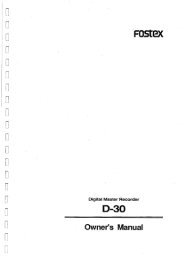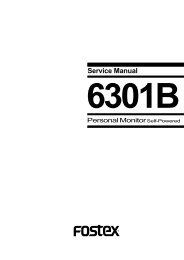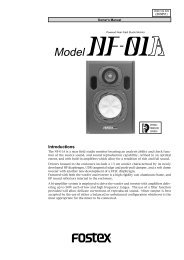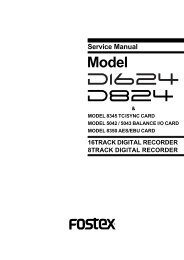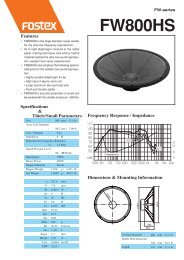audio file in the INSERT mode - Fostex
audio file in the INSERT mode - Fostex
audio file in the INSERT mode - Fostex
You also want an ePaper? Increase the reach of your titles
YUMPU automatically turns print PDFs into web optimized ePapers that Google loves.
Record<strong>in</strong>g<br />
1. Press <strong>the</strong> [RECORD] key.<br />
"New File!" appears for a short time on <strong>the</strong> display and <strong>the</strong> unit starts record<strong>in</strong>g on <strong>the</strong> newly created<br />
<strong>file</strong> with <strong>the</strong> <strong>file</strong> format set <strong>in</strong> <strong>the</strong> procedure described <strong>in</strong> <strong>the</strong> previous "Preparation for record<strong>in</strong>g".<br />
A tentative title of <strong>the</strong> newly created <strong>audio</strong> <strong>file</strong> is automatically created and registered. The tentative<br />
title conta<strong>in</strong>s date/time <strong>in</strong>formation. In <strong>the</strong> follow<strong>in</strong>g example, <strong>the</strong> tentative title shows that <strong>the</strong><br />
record<strong>in</strong>g started at 18H:30M:00S on 24th, December, 2001. The date/time is based on <strong>the</strong> <strong>in</strong>ternal<br />
clock, which should be adjusted before us<strong>in</strong>g <strong>the</strong> unit. (See "Sett<strong>in</strong>g <strong>the</strong> <strong>in</strong>ternal clock" <strong>in</strong> Chapter 1<br />
for details about how to set <strong>in</strong>ternal clock.)<br />
You can edit <strong>the</strong> tentative title us<strong>in</strong>g <strong>the</strong> "File Title Edit?" menu <strong>in</strong> <strong>the</strong> Utility <strong>mode</strong>.<br />
Tentative title<br />
The appropriate tracks<br />
accord<strong>in</strong>g to <strong>the</strong> [TR<br />
MODE] switch sett<strong>in</strong>g is<br />
lit.<br />
1<br />
2<br />
ABS<br />
H M S F<br />
∞ 60 50 42 34 28 2018 12 8 6 5 4 3 2 1 0 OL<br />
PGM<br />
BIT<br />
FS<br />
kHz<br />
-0.1%<br />
FORMAT<br />
BWF<br />
48<br />
24<br />
File number<br />
The appropriate Bit and<br />
Fs numbers accord<strong>in</strong>g to<br />
<strong>the</strong> [SAMPLING FREQ]<br />
switch sett<strong>in</strong>g is lit.<br />
The appropriate <strong>file</strong> format accord<strong>in</strong>g to<br />
<strong>the</strong> [AUDIO FILE] switch sett<strong>in</strong>g is lit.<br />
Tips: File number for a newly created <strong>file</strong><br />
Audio <strong>file</strong>s automatically created are <strong>in</strong>ternally counted <strong>in</strong>dependently by "BWF" and "SDII" <strong>file</strong>s. For example,<br />
if you make record<strong>in</strong>gs twice to a disk on which no <strong>audio</strong> <strong>file</strong> is available by sett<strong>in</strong>g <strong>the</strong> [AUDIO FILE]<br />
switch to "BWF", two "BWF" <strong>file</strong>s are created, whose <strong>file</strong> numbers are "01" and "02". Then if you make a<br />
record<strong>in</strong>g to this disk by sett<strong>in</strong>g <strong>the</strong> [AUDIO FILE] switch to "SDII", <strong>the</strong> <strong>file</strong> number of <strong>the</strong> newly created <strong>file</strong><br />
is "01". In result, two BWF <strong>file</strong>s and one SDII <strong>file</strong> are created. A new <strong>file</strong> number is one greater than <strong>the</strong><br />
number of exist<strong>in</strong>g <strong>file</strong>s of <strong>the</strong> same <strong>file</strong> format.<br />
2. After record<strong>in</strong>g, press <strong>the</strong> [STOP] key to stop <strong>the</strong> unit.<br />
See <strong>the</strong> next page for details about how to playback a recorded <strong>audio</strong> <strong>file</strong>.<br />
Tips: Record<strong>in</strong>g level adjustment of analog <strong>audio</strong> signals<br />
Each level meter on <strong>the</strong> display holds peak value of <strong>the</strong> correspond<strong>in</strong>g <strong>in</strong>put signal (see <strong>the</strong> display example<br />
below).<br />
The peak hold time is <strong>in</strong>itially set to 3 seconds, however, you can select <strong>the</strong> time among from 0 to 9 seconds<br />
<strong>in</strong> 1 second steps and <strong>in</strong>f<strong>in</strong>ity us<strong>in</strong>g <strong>the</strong> "Peak Hold?" menu <strong>in</strong> <strong>the</strong> Setup <strong>mode</strong>. See "Chapter 11: Setup <strong>mode</strong>"<br />
for details.<br />
You can also check <strong>the</strong> marg<strong>in</strong> between <strong>the</strong> allowable maximum <strong>in</strong>put level (= 0 dB) and <strong>the</strong> actual loudest<br />
level. The marg<strong>in</strong> value (<strong>in</strong> dB) is updated each time when <strong>the</strong> loudest signal is fed to <strong>the</strong> unit.<br />
So you can use <strong>the</strong> marg<strong>in</strong> display function <strong>in</strong>stead of sett<strong>in</strong>g <strong>the</strong> peak hold time to <strong>in</strong>f<strong>in</strong>ity. You can reset <strong>the</strong><br />
current marg<strong>in</strong> value by press<strong>in</strong>g <strong>the</strong> [MARGIN RESET] key.<br />
Us<strong>in</strong>g <strong>the</strong> [DISP LEVEL] key, you can choose what is shown on <strong>the</strong> display among <strong>the</strong> marg<strong>in</strong> level, track level<br />
and time.<br />
1<br />
2<br />
H M S F<br />
ABS<br />
PGM<br />
BIT<br />
FS<br />
kHz<br />
∞ 60 50 42 34 28 2018 12 8 6 5 4 3 2 1 0 OL -0.1%<br />
FORMAT<br />
BWF<br />
<strong>the</strong> peak value is hold.<br />
48<br />
24<br />
CLOCK<br />
-INT-<br />
CLOCK<br />
-INT-<br />
Notes for level adjustment:<br />
• Set <strong>the</strong> record<strong>in</strong>g level with <strong>the</strong> [INPUT MON]<br />
<strong>in</strong>dicator lit.<br />
• Adjust <strong>the</strong> record<strong>in</strong>g level us<strong>in</strong>g <strong>the</strong> [INPUT<br />
LEVEL] control so that <strong>the</strong> "OL" <strong>in</strong>dicator does<br />
not light at <strong>the</strong> loudest part of <strong>the</strong> signal (i.e.<br />
<strong>the</strong> marg<strong>in</strong> value is larger than 00.0 dB). If<br />
<strong>the</strong> <strong>in</strong>put signal is too high, <strong>the</strong> recorded<br />
sound is distorted.<br />
4-5






